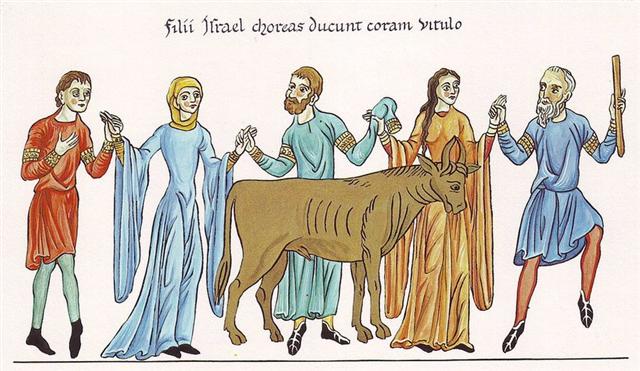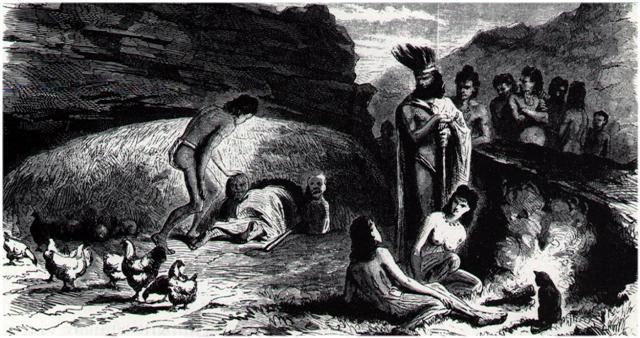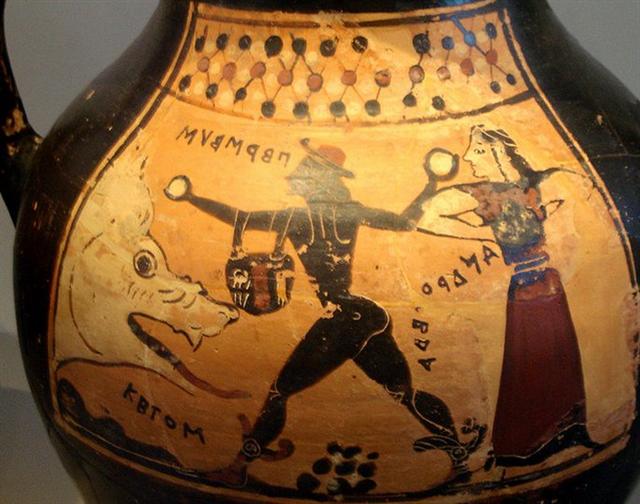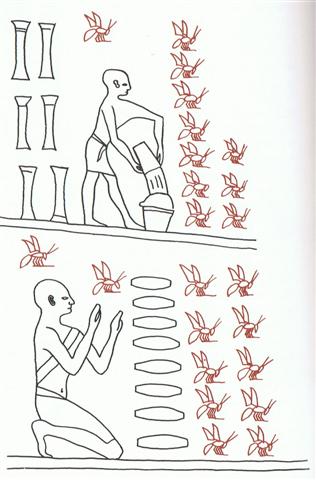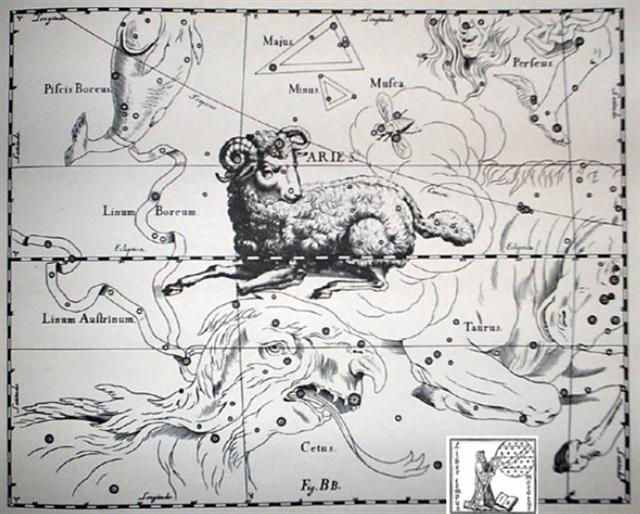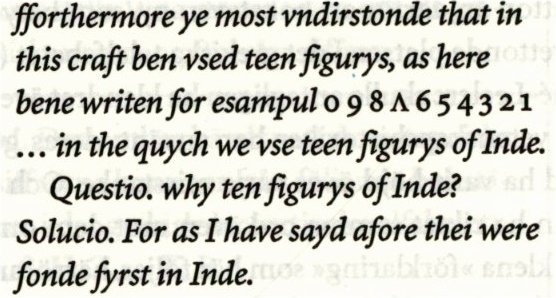|
TAHUA
30 Once again. In order to escape from the monstrous man-eating Polyphemus (tagata kai = a man is eating, kai tagata = a cannibal).the clever Odysseus had a trick up in his sleeve: ... There remained, however, the problem of getting out of the blocked cave. The Cyclops, groaning, groping with his hands, lifted away the stone from the door, and himself then sat at the entry. And Odysseus cleverly lashed together three large rams of the flock, 'well nurtured and thick of fleece, great and goodly, with wool as dark as violet'. And he prepared in all six triads of this kind. The middle ram of each set was to carry a man clinging beneath, while the side pair were to give protection. And as for himself, he laid hold of a goodly young ram, far the best of all, and curled beneath his shaggy belly; and as soon as early dawn shone forth, the nineteen rams, together with the flock, issued from the cave, bearing seven men ...
Strangely the colour for the wool was not purple (→ for the king), but instead it was said to be 'as dark as violet'. The precious purple colour reserved for kings was fetched from mollusca down in the 'purple' sea according to the perception of the ancient Greeks,
and Polyphemus was the son of Poseidon, but his cave was located neither at sea nor on dry land: ... Odysseus and his fleet were now in a mythic realm of difficult trials and passages, of which the first was to be the Land of the Cyclopes, 'neither nigh at hand, nor yet afar off', where the one-eyed giant Polyphemus, son of the god Poseidon (who, as we know, was the lord of tides and of the Two Queens, and the lord, furthermore, of Medusa), dwelt with his flocks in a cave ... 6 * 3 + 1 = 19 sheep in all were needed for their escape out from the cave of night,
... Sky (rangi) and Earth (papa) lay in primal embrace, and in the cramped, dark space between them procreated and gave birth to the gods such as Tane, Rongo and Tu ... which could have alluded to day 400 + 19 = FEBRUARY 23 (TERMINALIA). ... The Sacred Book of the ancient Maya Quiche, the famous Popol Vuh (the Book of Counsel) tells of Zipacna, son of Vucub-Caquix (= Seven Arata). He sees 400 youths dragging a huge log that they want as a ridgepole for their house. Zipacna alone carries the tree without effort to the spot where a hole has been dug for the post to support the ridgepole. The youths, jealous and afraid, try to kill Zipacna by crushing him in the hole, but he escapes and brings down the house on their heads. They are removed to the sky, in a 'group', and the Pleiades are called after them ...
But 63 sheep → 9 weeks could also have alluded to MARCH 20 (79 → 7 * 9 = 63) and to the 'rainy' (ua) star Hyadum I (*63.4), i.e. to May 23 (*428 → 400 + 28). And 60 + 63 ↔ 123 (May 3) ↔ FEBRUARY 28 (59 → 2 * 29½). Like the dark moon night named Ohiro (↔ Mercury) Odysseus himself would have been out of sight below the 'goodly young ram' at Hyadum II ← no glyph.
Perseus strides across 9 'stone boulders' (→ 9 days, weeks, months, or years; tau-iva) when liberating Andromeda. And the figure inside the 'godboat' type of glyph might have corresponded to the Greek letter lambda (Λ) ↔ the wide open legs of Perseus: Atea, The name of the district or section of country over which Olopana is to have ruled in Kahiki was in Hawaiian Moa-ula-nui-akea. Analyzing this word, it consists of one appellative, Moa, and three adjectives or epithets, ula, nui, akea, 'red, great, open, or wide-spreading' ... (Fornander). Pau.: fakaatea, to remove, to put away. Ta.: atea, clear. Mq.: atea, id. Sa.: ateatea, wide, spacious. Ma.: atea, clear. Churchill.
This letter (Λ) was the last one in the first group of Phoenician letters, i.e. the 'godboat' could have served the function of transporting the terra firma group (lambda as pars pro toto) across the night waters of the 2nd group of letters: ... The first half beginning with Alef - an ox, and ending with Lamed - a whip. The second list begins with Mem - water, and continues with Nun - fish, Samek - fish bones, Ayin - a water spring, Peh - the mouth of a well, Tsadi - to fish, Kof, Resh and Shin are the hook hole, hook head and hook teeth, known to exist from prehistoric times, and the Tav is the mark used to count the fish caught ...
... At the beginning of 44 B.C. - when Ceasar was still alive - the Senate decided to raise statues of him in all the temples and to sacrifice to him on his birthday in the month Quintilis, which in honour of him was renamed July. He was raised to the status of a god (among the other gods of the state) under the name Jupiter Julius. Marcus Antonius, who this year was consul together with Caesar, became high priest and responsible for the ceremonies. In the middle of February, at the time of the old feast of Lupercalia [Lupus = Wolf], he ran around naked and whipped the Roman ladies with thongs made from goat-skin [februa], in order to promote their fertility ...
... Strassmeier and Epping, in their Astronomishes aus Babylon, say that there its stars formed the third of the twenty-eight ecliptic constellations, - Arku-sha-rishu-ku, literally the Back of the Head of Ku, - which had been established along that great circle milleniums before our era; and Lenormant quotes, as an individual title from cuneiform inscriptions, Dil-kar, the Proclaimer of Dawn, that Jensen reads As-kar, and others Dil-gan, the Messenger of Light. George Smith inferred from the tablets that it might be the Star of the Flocks; while other Euphratean names have been Lu-lim, or Lu-nit, the Ram's Eye; and Si-mal or Si-mul, the Horn star, which came down even to late astrology as the Ram's Horn. It also was Anuv, and had its constellation's titles I-ku and I-ku-u, - by abbreviation Ku, - the Prince, or the Leading One, the Ram that led the heavenly flock, some of íts titles at a different date being applied to Capella of Auriga. Brown associates it with Aloros, the first of the ten mythical kings of Akkad anterior to the Deluge, the duration of whose reigns proportionately coincided with the distances apart of the ten chief ecliptic stars beginning with Hamal, and he deduces from this kingly title the Assyrian Ailuv, and hence the Hebrew Ayil; the other stars corresponding to the other mythical kings being Alcyone, Aldebaran, Pollux, Regulus, Spica, Antares, Algenib, Deneb Algedi, and Scheat ...
My idea, if true, could then be used in order to illuminate the pair of complementary glyph types inoino and maitaki:
One corner of a rhomb could have been counted as a week and a completed rhomb could have been counted as a whole month (4 * 7 = 28).
A triplet of rhombs would then count as 3 * 28 = 84 days (→ Julian equinox) and also as a quarter of 336 (= 48 weeks). ... The author of the Book of Enoch in his treatise on astronomy and the calendar also reckoned a year to be 364 days, though he pronounced a curse on all who did not reckon a month to be 30 days long ... The 'good' maitaki design could be a complementary figure; 6 * 30 = 180 and after the single vertical straight line was added its measure could have been 181 or 180 + 3 (→ cold food) = 183. ... ka-âmo te hare, ka haka-maitaki, clean the house, make it good ... The upraised right knee of the Egyptian god Shu ... Hercules first appears in legend as a pastoral sacred king and, perhaps because shepherds welcome the birth of twin lambs, is a twin himself. His characteristics and history can be deduced from a mass of legends, folk-customs and megalithic monuments. He is the rain-maker of his tribe
ko te tagata mau i te ua and a sort of human thunder-storm. Legends connect him with Libya and the Atlas Mountains; he may well have originated thereabouts in Palaeolithic times. The priests of Egyptian Thebes, who called him Shu, dated his origin as 17,000 years before the reign of King Amasis. He carries an oak-club, because the oak provides his beasts and his people with mast and because it attracts lightning more than any other tree. His symbols are the acorn; the rock-dove, which nests in oaks as well as in clefts of rocks; the mistletoe, or Loranthus; and the serpent. All these are sexual emblems. The dove was sacred to the Love-goddess of Greece and Syria; the serpent was the most ancient of phallic totem-beasts; the cupped acorn stood for the glans penis in both Greek and Latin; the mistletoe was an all-heal and its names viscus (Latin) and ixias (Greek) are connected with vis and ischus (strength) - probably because of the spermal viscosity of its berries, sperm being the vehicle of life. This Hercules is male leader of all orgiastic rites and has twelve archer companions, including his spear-armed twin, who is his tanist or deputy ... illustrates where to find Λ, viz. below the arching body of mother night (Nut) - at her belly, at the black moon - and down on the plane day of terra firma at high summer:
By the way, the Swedish word for number 'seven' is sju, which I think hardly is a coincidence. For it is pronounced precisely as someone in Sweden would pronounce Shu.
|
